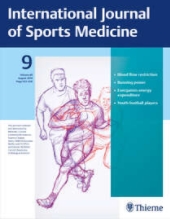Francini L1,2, Rampinini E1, Bosio A1, Connolly D3, Carlomagno D1, Castagna C2,4.
1, Human Performance Laboratory, Mapei Sport Research Centre, Olgiate Olona, VA, Italy; 2, Italian Football Federation (FIGC) Technical Department, Football Training and Biomechanics Laboratory, Coverciano, Italy; 3, Juventus FC, Sport Science, Torino, Italy; 4, Universita’ degli Studi di Roma Tor Vergata, School of Sport and Exercise Sciences, Roma, Italy.

ABSTRACT
The aim of the study was to examine the associations between maximal and submaximal field tests with match physical activity and biological maturation in youth football players. Sixty-eight youth football players (U14, U15, U16, U17) performed maximal and submaximal field endurance tests. Biological maturity was estimated calculating the distance from peak height velocity (Y-PHV). Physical match activities were tracked using GPS units and players’ post-match rate of perceived exertion (RPE) was recorded. Mainly moderate associations were found between field tests and match activities. Large correlations were found between Yo-Yo Intermittent Recovery test level 1, distance covered at high and very high-speed running, the quantity of very high and maximal metabolic power running. Small to moderate associations between match activities and Y-PHV were observed. The magnitude of correlation between match activities and field tests increased from moderate to large when matches with an RPE>5 were considered. The results provide further evidence of the association between young football players’ aerobic performance and match work rate. Submaximal field tests demonstrate ecological validity and may constitute a practical alternative to performing maximal tests. Maturation was found to have a moderate effect on youth players’ match work rate.
Int J Sports Med. 2019 Sep;
PMID: 31272110 DOI: 10.1055/a-0938-5431